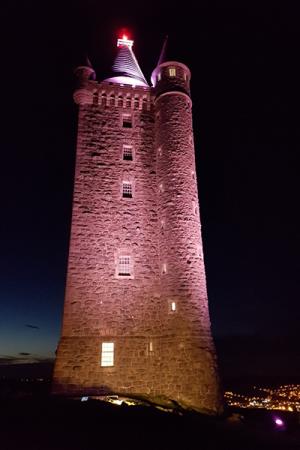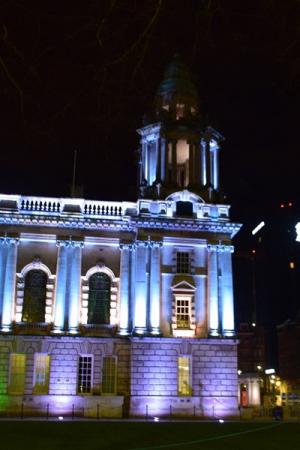General considerations

The application of dedicated external lighting offers the opportunity for communities to showcase their building heritage and improve public places.
It has been established that lighting a historic building, such as a church for example, will elevate its presence in the community. It should be remembered that external lighting can not only augment the view of a historic building but if done badly can produce the opposite effect by enhancing the negative aspects.
Before installing external lighting to any historic structure or area, due consideration must be given to:
- Where the building is located, whether it is rural or urban
- How much of it should be lit
- Any neighbouring properties and spaces that might be affected
- The location of the lighting so as to reduce the visual impact the fittings have on the daytime view
Any successful lighting design scheme must involve artistry as well as technical expertise. The main objectives of a good external lighting scheme should be:
- To create the desired aesthetic presentation of the building and its surroundings
- To give a building an added dimension and greater night time presence and which enhances its key architectural features as well as its social and heritage significance
- To elevate the ‘after darkness’ experience and promote a more inclusive and safe night-time local economy with more people enjoying a vibrant cultural life
- To improve and promote the observation and experience of the heritage building or setting against the night sky
- To ensure that the right quality, quantity and colour of light is used to give the best lighting experience
- To ensure that the daytime view of the building or space is not marred by poorly located electric light units (which are technically called ‘luminaires’)
- That sufficient protection against potential vandalism to the installation has been taken
- That the lighting scheme is reasonably easy to maintain and has the appropriate controls to allow suitable adjustment to time of day and potential incidents
- Lastly that the environmental and wildlife impacts has been kept to an absolute minimum; that there is the least amount of light pollution or overspill and the energy efficiency of the installation has been maximised
Well-designed external lighting can, with care and sensitivity, bring added life and scope to our treasured heritage landmarks. It becomes an extension to the architecture or place, improving the visitor experience by complementing the building’s shape, colour and form. Its added dynamic can be compared to ‘painting with light’.
It is important that, before a design is completed, anyone thinking of externally lighting their heritage building or its environs should work through the key considerations below.
Design concept

Before embarking upon an external lighting project, a clear brief should be compiled by the client working with their lighting designer or engineer. This will help consolidate the parameters of any future design and will help limit the scope of works to what is necessary to achieve the stated aims. It will also help with controlling project creep which in turn will assist in controlling the associated design and installation costs.
It is the lighting designer’s duty to limit the amount of light and electric light units (luminaires) to the minimum that delivers all their client’s requirements and the building’s needs.
Does the entire building or area need to be lit?
It is rarely necessary to light all the elevations or features of a building or space. Some parts are often unsuitable or inaccessible for normal viewing so it makes no sense in lighting them to make them stand out. It is usually better to concentrate on the best nearby and/or distant night-time viewpoints. As part of the design process, the potential distance away, the angle and position of any visitor should always be taken into account.
Is there a pattern or arrangement which should be featured?
Rather than illuminating the whole building it is often better to select features such as pediments, columns, niches and cornices to light. Consider using your external lighting scheme to reinforce a building or area’s patterns and improve the night time appreciation of the architectural details or the space’s features, including public artworks.
Consider lighting techniques such as cross-lighting, up-lighting and back-lighting, although up-lighting should be limited and well controlled to avoid unnecessary and wasteful upward light spillage and pollution.
Lighting designs can be refined by using tightly controlled narrow beam, asymmetric fittings sometimes supplied with baffles and shutters to help reduce night-time light spill as well as highly responsive, remote management and control of light installations via such systems as 4G/5G mobile telephone networks.
However, any physical lighting control solution can cause issues for daytime viewing unless the luminaires are carefully and discreetly located.
Can the external lights be discreetly located?
It is important to position as many external electric light fittings (luminaires) as possible where they are inconspicuous while still being relatively easy to access for maintenance. It's also crucial that the luminaire fixing locations are respectful of the historic fabric and will leave no permanent scarring. A particular lighting layout may give the desired effect at night but if the floodlights cannot be hidden or suitably disguised for daytime viewing, the scheme has ultimately failed.
Potential solutions include:
- Positioning the light fittings on neighbouring street furniture
- Disguising a remote location with planting or trees
- Installing luminaires on another suitably located nearby building but this can be difficult if it is not your property
How big and clean is the building?
As well as considering the existing ambient light levels coming from street lighting, shops and offices, you should also think about the reflectivity of the building surfaces when designing your lighting scheme.
Reflectivity is affected by the colour of the building materials and/or how clean they are. The lighter the colour or cleaner the material, the more light will be reflected back into the space and the fewer or less powerful electric light units/ luminaires you will need. The colour of the surfaces being lit will also likely help determine the colour temperature of the lamps used in the scheme.
What adverse issues could result from the proposed lighting?
The following issues are very important and need to be considered carefully:
- Light pollution, sky glow and wildlife issues
- Over-lighting areas and timing
Light pollution, sky glow and wildlife issues
Light pollution from a badly designed lighting scheme can be a major problem and is also a waste of energy.
Annoying light spillage into neighbouring properties and the surrounding area can have adverse health effects for residents too.
Check with your local planning authority whether Planning permission is required for your lighting scheme.
External lighting can be extremely disturbing to a variety of plants, birds, fish and other animals. Excessive light can impact on the lives of nocturnal species such as bats, owls, and insects, confusing their patterns of sleep, feeding, hibernation and thus endangering them. For example, a reduction in the number of insects will reduce the food supply for birds and mammals. It is an offence to disturb protected species such as bats. The Bat Conservation Trust and the Institution of Lighting Professionals provides detailed advice.
Badly designed external lighting schemes can also interfere with important astronomical observation and research as well as those who merely want to enjoy and study the night sky.
There is a network of national and local astronomy and environmental organisations supporting the establishment of more places where dark skies can be re-established or developed. They want to create an awareness of these places and encourage tourism so that more people can enjoy the night sky.
Any light generated should be used only where it's needed, and we should think of it as a valuable commodity which should be used sparingly. In rural locations it's even more essential that any potential external lighting scheme is extremely well controlled and not allowed to operate all night.
Over-lighting areas, and timing
Also, when it comes to rural areas, with lower ambient light levels, there are frequent issues with over-lighting that can produce the effects outlined above. This can happen when designers forget to adjust their approach to external lighting when their schemes do not have to compete with high levels of other lighting such as those found in town and city centres.
It's also important to have suitable controls for any external lighting scheme that not only allow for remote adjustment if suitably sophisticated, but that also prevent external lighting being on all night. This one aspect can be achieved with a relatively simple timer or photocell. In reality after 01:00 hours there is very little to be gained in continuing to illuminate any building especially in more rural areas where the impact of too much light will be felt more keenly.
Listed Building Consent
Scheme proposals should give details of the lighting units they propose and how they are to be fixed. Bolting, screwing or bracketing, directly in contact with the building should be carefully considered.
As outlined above, often lighting situated further away from a structure will have a better coverage and allow a more complementary scheme. This also avoids damage to the building. If a fixing is agreed it must be achieved using non-rusting or non-staining elements, i.e. stainless steel, bronze, plastic or the like should be employed. The lighting units and the cable routes must be designed in a way that does not impede the rainwater run-off from the building. This means they must avoid cill, drip courses, etc and other architectural features.
The designer’s overall aim should be to make the installation as discreet as is practically possible for both the light fittings and the cable runs. The following must also be considered:
- Listed building consent must be sought, if the fittings would affect the special architectural or historic interest of the building.
- Where possible, light-fittings should be set on the ground or on a nearby structure, not attached to listed fabric.
- Fittings mounted at ground level should be concealed in the curtilage of a building, in basement wells, or in planting, or set into the ground; they should not normally be mounted on new columns.
- A building should normally be lit by only one colour of light; in some circumstances, a second colour can be used to good effect, but, in any event, the colour of the light source should be chosen to complement the building materials.
- A new scheme should complement neighbouring lit buildings, not compete with them.
Bibliography
Further reading
- External Lighting of Historic Buildings, Historic England.
- View the recording of the English Heritage 2020 webinar: External lighting for historic buildings and churches.
Contractors
The Department cannot recommend specific contractors for restoration work. However, this is a skilled field and owners and their agents should satisfy themselves that those they employ have the required skills. Previous examples of their work should be inspected, and recommendations sought.
UK and Ireland contractors who claim to have restoration experience are now listed online; The Directory of Traditional Building Skills, compiled and published by Ulster Architectural Heritage in association with HED can be accessed via the UAH website.
The Irish Georgian Society publishes a list of specialist contractors based mainly in the Republic of Ireland.
